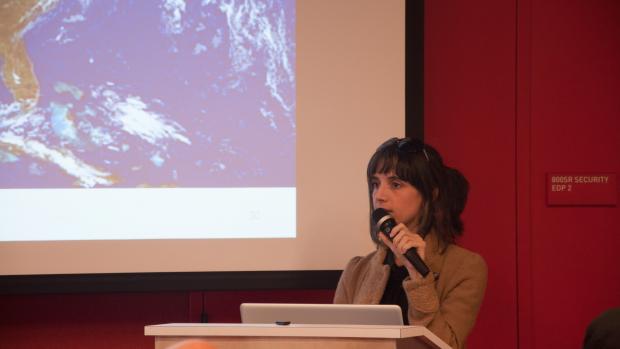Saving the World, One Click at a Time

Everyone knows what crude oil is, but soon we might all be talking about “Rude Oil.” That’s the name adopted by a team of sustainable urban environments and integrated digital media students who have been working on a project to chart oil spills and their effects in the Niger Delta. Using a geographic information system, the students—Iffat Jahan, Rosa Pena, Chris Giamarino, and Cody Fulcher—analyzed 2011-2014 data from the Shell Oil Company and put their findings into a visually appealing, easy-to-understand format that they hope will attract attention on the web. “These spills affect farmlands and sources of potable water, but there are not only environmental consequences,” Jahan explained. “Issues of social justice, like access to safe, affordable housing, crop up too.” Done under the direction of Professor Rich Wener and Adjunct Professor Brian MacMillan, Rude Oil was just one of the ambitious capstone projects exhibited during the Department of Technology, Culture and Society’s conference “Environmental Activism in the Digital Age: Saving the World in Bits and Bytes,” which took place on April 2.
Thanks to experts who spoke during the conference—a stellar line-up led by David Miller, president and CEO of the World Wildlife Fund-Canada and a Future of Cities Global Fellow at the NYU Polytechnic School of Engineering—those students now have an even better idea of how to effectively use digital strategies to address environmental issues and promote activism.
“Simple, clear messages, repeated often by a variety of trusted voices—that’s key,” Edward Maibach, the director of the Center for Climate Change Communication at George Mason University, explained to the large audience during a panel session on “the art and science of persuasion.” “But that’s not as easy as it sounds. It takes a team: content experts who know the issues, social scientists who understand how people behave and react, and communications professionals who know how to craft a message.”
There were plenty of examples on view at the subsequent panels. Speaking at a session devoted to “digital strategies that work,” Terry Macko, the senior vice president of communications and marketing at the World Wildlife Fund-U.S., displayed an eye-catching website and series of posters aimed at eradicating poaching, and illegal trade of wildlife in the global marketplace; the campaign prominently featured tigers, rhinos, and elephants—what he termed “charismatic mega-fauna”—but it went beyond tugging at heartstrings. “These activities are crimes,” Macko stressed, “and we let people know that.”
Among the other speakers were Adrianne Koteen, a photographer who discussed the overlap between art and activism, and representatives of the Yes Lab, a group devoted to helping activists carry out media-getting creative actions. Among their most-buzzed-about stunts was the staging of a fake gala at Seattle’s Space Needle to “celebrate” Shell’s Arctic drilling program. The event—during which a drink dispenser fashioned to look like a miniature oil rig malfunctioned, spraying the guests—was widely reported in the media, both before and after being revealed as a hoax.
Although the conference was focused on environmental activism, the lessons imparted during the day have undeniable applicability in other areas. “Digital media can be a great way to educate and inspire,” David Miller asserted, “and to motivate and mobilize.”




